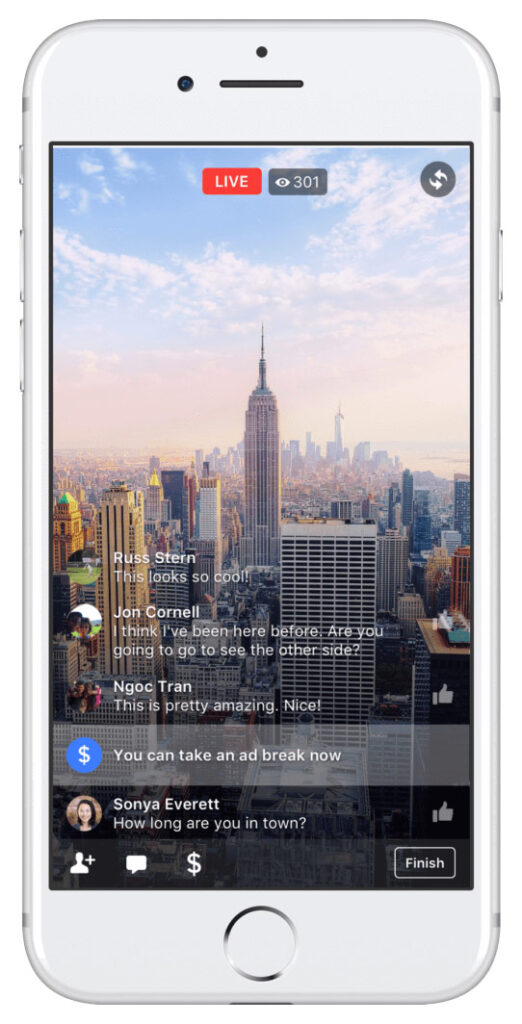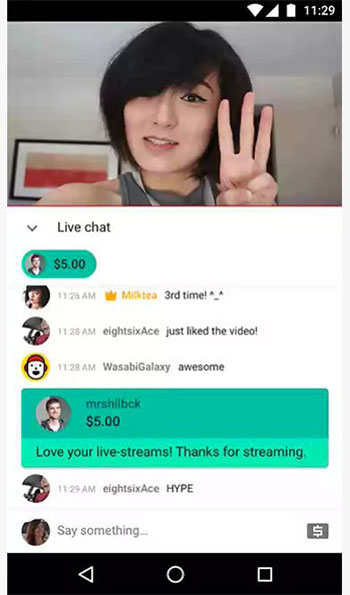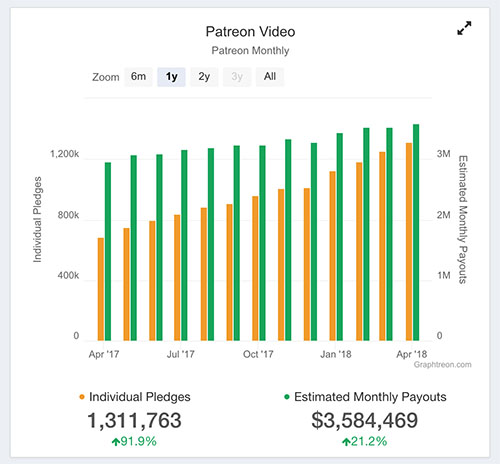In one of our previous pieces, we’ve discussed how live streaming can help a brand grow and reach a wider audience. And while it is easy to understand how a large company can profit financially from a large following (more product and service sales), a large audience is no profit guarantee for brands, whose final product is video content. We are talking of course about online video creators, who above all enjoy sharing their live videos with the world. In this article, we want to examine the direct ways for video content creators to profit from live streaming. Here are six methods to help you learn how to make money streaming live video:

1. Run ads during your live stream
Yes, those good old pre-roll and mid-roll ads found their way into live video as well. The revenue is calculated based on the total number of people who see the ad.
At the end of last year Facebook added the ad capability to their live videos. During a live broadcast, certain streamers will see the option to take a short break and have an ad play during that time. Users will be shown a brief Facebook video ad, and then the live broadcast would resume. Unfortunately, not every content creator will qualify: you need to have more than 50,000 followers, need to have reached 300 or more concurrent viewers in a recent live video, you must be a Facebook Page, and finally your current live video must first reach at least 300 concurrent viewers. If all of these criteria are met, only after at least 4 minutes will you be able to take an ad break.

YouTube allows desktop streamers to insert mid-roll ads into their live stream. The creator can click “Play Ad” at any point during the live event. This could also be a great opportunity for the creator to take a breather. However, remember to warn your viewers ahead of time before cutting to a commercial break so they know what’s going on.Calculating the revenue from mid-roll ads can be tricky. Typically, ad monetization is discussed in terms of CPM (stands for Cost Per Mille, a.k.a. cost per one thousand views), which is a metric of how much it will cost for the advertiser to show their ad to 1,000 people (this number is different for each topic pool). The reason creator RPMs (Revenue Per Mille) are almost never mentioned is because they are often hard to predict: they can vary greatly depending on your audience size and CPM for that particular ad.
In addition, many creators point out that live ads are not really a significant source of income. Since revenue is derived from total number of clicks or views, the payout depends a lot on how many people see the video. And while VOD content is capable of accumulating those numbers over time, live videos that run ads must rack up an unbelievable amount of live viewers in order to profit significantly. As a study by Digiday.com suggests, running ad breaks during live streams may not really be worth it.
2. Fan donations
In their recent market study, Deloitte predicts that live streaming revenue should reach $7.4 billion in 2018, a 47% increase over the previous year. The study also points out that “the primary revenue model for this market is likely to be tipping, whereby viewers donate money to performers”. The ease with which fans today are able to support their favorite creators with donations is indeed game changing. This new revenue model can allow those who love creating videos, art, music, and other types of content to learn how to make money streaming, get rewarded for their work, and actually turn their passion into a profession.
Perhaps when you hear “online donations”, the thing you think of are those PayPal “donate” buttons on websites and YouTube pages. Live streaming platforms have actually moved way past that, integrating fan donation systems right into their interface and gamifying the process.
Take LiveU for example, a mobile app that lets you livestream your daily activities (or whatever creative activities you can come up with). It has an elaborate system of gifts that can be bought for coins, which in turn must be purchased with real money. There is also a gifting hierarchy system, rewarding those, who give the most expensive gifts. This gamification process makes it fun and almost tempting to donate. Creators can then exchange these gifts back into real currencies.

YouTube Live came up with something called Superchat to reward their creators. A live video creator can enable donations during their live stream and viewers will have the ability to send donations in real time. All donations will appear in the Live Chat window on the right. The more a user donated, the longer their message remains pinned. The color of the message background is also determined by the amount paid. The creator gets the money while the patron gets the gratification of a personal shout out.
YouTube keeps 30% of all Superchat donations. If you are interested in keeping more of your donations for yourself, consider using a Streamlabs widget. Among other things, Streamlabs allows you go set up a direct donation link or button on Twitch, YouTube, Mixer and Facebook Live. Collect tips from your fans to your PayPal, credit card, Skrill and a few other wallets with no fee.
3. Pay per view/subscriptions
The pay per view model asks fans to pay a certain amount to unlock access to an item creator’s “hidden” live content. This content is usually more special and unique than the open content (it has to be worth paying for). Similarly, a subscription gives access to all creator’s exclusive content for a period of time (think Netflix). Subscriptions are essentially scheduled monthly donations.
Some streamers take advantage of the built-in subscription features that numerous live streaming platforms offer (Vimeo Live, IBM Cloud Video, etc). A monthly subscription includes perks for viewers such as special badges, the ability to chat during subscriber-only mode, and ad-free live streams.Others rely on a facilitating service, such as Patreon. Patreon is currently one of the most influential donation platforms, shaping the financial future and freedom of many creators. Patreon makes membership businesses for creators possible. Just over the past year, Patreon made it possible for their video creators to receive more than $3.5 million! And while Patreon is not a live streaming platform itself, integration with Youtube, Twitch and Facebook Live is easy. Sounds like a sweet deal for the creator. However, the creator now also has to work extra hard to keep their audience interested and to not break that trust. Streamers are encouraged to make teasers and give previews of what’s behind the curtain. Also be sure to thank your supporters, both over your live stream as well as with cool perks.
Sounds like a sweet deal for the creator. However, the creator now also has to work extra hard to keep their audience interested and to not break that trust. Streamers are encouraged to make teasers and give previews of what’s behind the curtain. Also be sure to thank your supporters, both over your live stream as well as with cool perks.
4. Affiliate programs
Affiliate programs are an excellent option to consider if you’re exploring how to make money streaming. Here is how affiliate programs work: you get a special product link (or promo code) from a sponsor, and then every time someone visits the link and buys the product – you get a percentage of the sale. Basically, it’s like working on commission.
This can be a great profit tool for live content creators. Let’s say a beauty blogger is demoing a curling iron over a live stream. Her viewers get to see exactly how the product works in real time, hence gaining more trust in the product. The affiliate program continues to work even after the stream becomes VOD content. And who knows, maybe the beauty blogger even got her curling iron for free from the sponsor as an added bonus. This beauty blogger is this video tells all about how she was able to make $1000 on a single product:

How To Make Money on YouTube with Affiliate Links
As the video above mentions, Amazon is a great place to start if you want learn how to make money streaming via affiliate programs. You can actually get bonuses if the viewer who clicked on your link made other (than your product) purchases during their session!
5. Brand deals and sponsorships
Striking a great deal with a large company is a dream for many creators. This type of income is valid for both live video and VOD content. However we feel that promoting a brand over live video makes the “ad” feel a bit more trustworthy, a tad more real. Profit from brand deals and sponsorships can vary drastically based on brand, your channel specificity, the size of your following, and more factors. Sometimes you get a good chunk of cash, sometimes you may be able to get free stuff from the brand.
How does one get a brand deal, you might ask? General advice here is:
Stay within your niche
If your channel is all about tech reviews – then definitely try to get a deal with a tech company. If you are doing beauty – then this is the area you should be looking for sponsorships. The general theme of your channel should tie in nicely with the brand you are promoting.
Don’t be afraid to ask
If your inbox is not overflowing with offers from brands – do not despair! Take the first step yourself. Write out exactly what you propose, approach your brand of choice (email, phone, in person) and just ask. Those who ask shall receive.
Less is more
It’s better to focus your attention on doing a great job for one brand, rather than spreading yourself thin and trying to catch a number of deals.
Don’t jeopardize your reputation
No brand is worth losing your entire following over. In the long run, reputation is much more important. Stick to brands and products you actually like and believe in.
There is a lot of great advice out there on securing brand deals and sponsorships. If you’re interested in learning how to make money streaming – be sure to check it.
6. Sell your merchandise
Creating and selling your own merchandise is a viable revenue model for all creators and live streamers learning how to make money streaming. Promoting your merchandise over a live stream could serve as great additional promotion for your swag. You could be wearing your own merchandise during your live stream, casually pointing out where and how to buy (include links!).
Sites like Merch by Amazon allow you to create and sell your designs on the with no upfront investment or costs.
Bonus tip: stack your revenue streams!
Naturally, the more shots you take – the greater your chances of success when you’re learning how to make money streaming. We recommend using a combination of these methods for best results. In addition to increasing your total profit, experimenting can also help you see which ones work best for you, and which only provide insignificant revenue at the cost of your valuable time and effort.
With all that said, please keep in mind that your live content still has to be of high quality! If your all your viewers see on your live stream are ads and merchandise pitches – you risk losing all of them forever. Don’t forget those live streaming basics, such as staying consistent with your streaming schedule, letting your personality shine, and entertaining your viewers and keeping them engaged. Check out our article 21 live streaming tips every content creator needs to hear for more solid tips.
Also remember that producing high-quality content is important. Epiphan’s Webcaster X2 is a smartly priced encoder, that can stream to Facebook Live, YouTube, or Twitch in resolutions up to 1080p.
Here is an infographic to help you remember:

How to make money streaming – the final word
It is truly an amazing time for creators of all kinds because of how easy it is to reward them for their work. By using live streaming to connect with many viewers all over the world, creators are now able to directly make money live streaming through fan donations, affiliate programs, running ads and much more. Have you learned how to make money streaming? Feel free to share your experience with live stream monetization in the comments below! Happy streaming!


If you’re a YouTuber who needs a way to collect donations online, consider using Donorbox. Donorbox is a secure and easy recurring donation platform that accepts cards, PayPal, Google Pay, Apple Pay and low fee ACH bank transfers as payments.